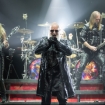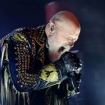The word "iconic" was made for albums like British Steel. Recorded in early 1980 at Startling Studios on Ringo Starr's 100-acre Tittenhurst Park estate in Ascot, England, and featuring the perennial Priest classics "Breaking the Law" and "Living After Midnight," the album's title was both a nod to the British Steel Corporation (where guitarist Glenn Tipton worked for five years) and a calling card for Judas Priest's galvanizing brand of English heavy metal. It also boasts what is arguably the band's most memorable cover: A giant razorblade bearing the Priest logo held firmly in the hand of what appears to be a leather-clad headbanger.

"It's actually the art director, Rosław Szaybo's hand," reveals British Steel photographer Bob Elsdale. "We made an oversized razorblade by having the album title and the Priest logo screen-printed on a cut-out piece of aluminum. There was no Photoshop in those days, so everything was shot for real." Szaybo and Esldale had worked together on Priest's previous album, 1979's Hell Bent for Leather (which was released in the U.K. under the title Killing Machine), and shot both covers in Elsdale's studio at St. John's Wood, London.
"I almost certainly used a wooden 4x5 [large format] Wista camera," the photographer explains. "The actual shoot didn't take that long—a couple of hours or something like that. All the work went into preparing the razorblade and screen-printing it."
In fact, Elsdale credits his Polish art director with masterminding the visuals for both British Steel and Hell Bent for Leather. "All the shots I did with Rosław were his concepts. He's really on the ball. He's 74 now, and he's still at it, teaching at Warsaw University and doing freelance work. And he's still in demand these days. Not bad for 74, is it?"
These days, Elsdale shoots mostly animal-based photography. He has produced two photo books—one of elephants (Gray Matter) and one of pigs (Pretty in Pink), both of which are available through his website, Bobelsdale.com. "I was doing album covers until people started using videos as a promotional tool," he explains. "All of a sudden, all of the money went out of the artwork budgets and into the videos."
Though Elsdale's metal days may have been short-lived, British Steel's razorblade clearly made its mark. It's been reproduced on T-shirts (of both the officially licensed and bootleg varieties) for the past 27 years, and even turned up in a 2001 Absolut Vodka ad bearing the legend "Absolut Priest."
"I'm really pleased with it," Elsdale says of the image he shot nearly three decades ago. "I think we did a great job. A lot of people looked at it and were really quite horrified. The edges of the blade seemed to be cutting into Rosław's flesh, because he was really gripping it quite hard. But that wasn't the case—it actually had blunt edges. It wasn't bloody, but it had an element of drama."
The original British Steel blade hung on the wall of Elsdale's studio for years. One day, it simply disappeared. "I think somebody made off with it," the photographer laments. "It's too bad—it would've been a nice thing to have today."












